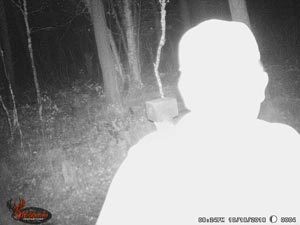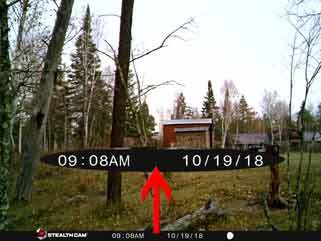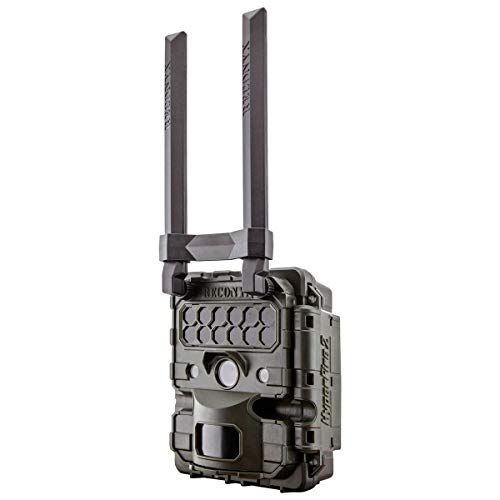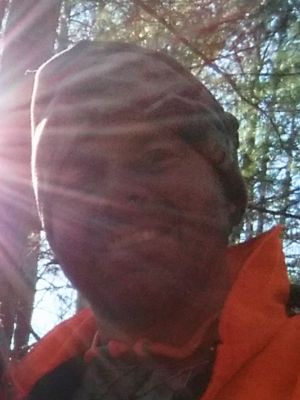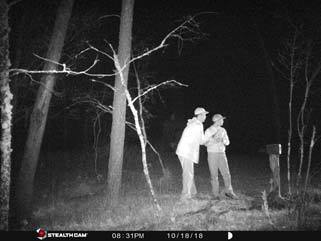
Criminals are seemingly getting bolder by the year. It doesn’t seem like it is enough anymore to lock things up or close a gate. Thieves and vandals seem to be a worry wherever you are. Whether you are talking about your home, your business, or vacation property the need for security and surveillance of your property is ever-increasing.
The monthly cost for a 24-hour electronic home security monitoring company can be expensive. Even if cost isn’t an issue for you sometimes you want to monitor something or someplace that is in a remote area where hiring one of these companies isn’t an option.
If you can’t afford a monitoring company or are in a remote area you still have another cost-effective security option to help you.
Trail cameras, also known as game cameras, can do more than help you monitor wildlife – they can also be used for security purposes.
Yes, that’s right. The same technology that is used by hunters and other outdoor enthusiasts can also help you secure your home or other property.
Here are the six cameras we recommend for security purposes. You can read our entire article to find out which situations each of them is best suited for.




Table of Contents
How Can I Use a Trail Camera for Home Security?
There are several things that make trail cameras a great tool to help provide security for your home or other property.
There are several things that make trail cameras a great tool to help provide security for your home or other property. For one, they’re relatively inexpensive and easy to set up. They can be left unattended for long periods of time. Many current models can record up to 4K HD video and take amazing pictures, even while remaining undetectable at night. They are also very portable and can be put in places that don’t have electric service. Plus, some of them can even send images directly to your cell phone or email account.
If you are worried about vandalism or theft of your property you don’t have to sit by and just hope for the best. You can use trail cameras as an easy-to-use and cost-effective way to monitor your property – even in remote areas.
However, before buying a trail camera for security purposes you need to know your specific needs so you can better understand the features you should be looking for when buying a camera.
Click HERE if you don’t want to read our buying guide and just want to read the reviews of the cameras we recommend.
What Are Your Security Needs? – Things to Consider
Daytime or Nighttime?
Some people want to monitor areas only during daylight hours because the area is inaccessible at night. Other people want surveillance specifically for the nighttime hours when an area is left unattended or unoccupied. While still, other people are looking for 24-hour security.
There are lots of trail cameras that take great pictures during daylight hours but have drastically different performance levels at night. Knowing whether or not you need the camera to help you with surveillance during the nighttime hours will help you get one that best meets your needs without the potential of spending money that you don’t have to.
Video or Pictures?
Some people will want a camera just to take pictures while other people might prefer to capture video.
Not all trail cameras capture video in the same resolution. If you are planning on having your camera record video as part of your surveillance plans you will want to pay closer attention to the video resolution the camera is able to capture.
Remember that most cameras will record video in shorter clip lengths during the nighttime house in order to conserve the batteries. This shorter clip length and might make some people reconsider if they want to use video or photographs to obtain surveillance information about their property.
How Far Away Will Your Trail Camera Be From the Area It is Monitoring?
Before buying a trail camera for security purposes you need to think about how far away the camera will be from the subjects it is trying to capture.
You will want to make sure that the camera you purchase has a detection range that is long enough to capture images of subjects in your desired area. On a similar note if you plan on capturing images or videos during nighttime hours you will want to make sure that the flash range of the trail camera is long enough to illuminate the area you are trying to monitor.
License Plates
If an unwanted person(s) comes onto your property to vandalize or steal something will they be most likely coming on foot or driving?
If you anticipate that people will be driving onto your property and you would like to be able to capture their license plates you should think about this in advance especially if you plan on capturing images of license plates in the dark.
Many trail cameras will have a hard time capturing license plate numbers in the dark where they will often look washed out. If you know that you would like to try and capture license plate numbers during the nighttime hours you might want to think about the Reconyx HL2X HyperFire 2 License Plate Capture Trail Camera, which was designed specifically for capturing license plates.
Where Can You Mount the Camera?
Ideally, you want to have the camera placed close to the area it is monitoring.
Remember that the further out you place the trail camera the more you need to be concerned with the resolution of the images the camera can capture (since you will most likely have to be enlarging them), the ability of the camera to detect things in your desired area, and the flash range if you want to capture images or video at night.
Conversely, if you place your camera just a couple of feet from the area you are monitoring you will run the risk of getting washed-out pictures at night. Here we can see an example of how this looks.
The subject looks whited out and you can see any details about them. People who aren’t familiar with trail cameras might think that the camera or flash is broken, but in fact, the only thing wrong is that the person being photographed is too close to the trail camera. As you can see the distance you place the camera from the area you are monitoring is important. So follow the manufacturer’s suggestions or play around with your trail camera when you are setting it up to test how the nighttime pictures look.
Another thing to keep in mind is that you don’t want to mount a trail camera that is used for home security in an area that is too conspicuous or obvious, otherwise the unwanted people on your property could easily steal the camera or the SD card that contains the pictures and videos you are capturing.
Do You Need Images to Be Sent To You?
People will have different needs or opinions in this area which makes them fall into one of two categories.
People Who Want Images Sent to Them
People who feel that it is important for images to be sent to them usually fall into one of the following situations:
- Some people who are worried that their camera is placed in an obvious and visible location might worry that the camera will be stolen before they can retrieve the pictures. So these people might be more interested in having a camera that can send pictures directly to them as they are captured.
- Other people might want to know as soon as something is happening so they can go to their property or call the authorities as soon as something happens.
- Still, others might be monitoring a more remote property. These people usually fall into one of two camps the first camp wants to know as soon as something happens since they don’t get to their property very often.
People Don’t Need Images Sent to Them
People who don’t feel that it is essential to have images sent to them usually feel that they are fine retrieving images or video manually just so long as they feel that the camera is not easily detectable and will still be there the next time they arrive at their property. These people also are on their property frequently and are able to retrieve images and video from their trail cameras on a regular basis.
Do You Need Your Trail Camera to Be Undetectable At Night?
If you plan on capturing images or videos at night you need to ask yourself how important it is for the camera to be undetectable. Specifically what we are talking about here is the flash that the camera uses to illuminate the pictures or video it is capturing.
Most people who plan on capturing images and videos at night when using a trail camera for security purposes want the flash to be invisible to the naked eye so they can keep the location of the camera hidden.
What Features Are Most Important for Trail Cameras Being Used for Security?
Photo Resolution
The resolution of a trail camera photo is always important for any number of reasons, but this is especially true when the trail camera is being used for security purposes. A higher resolution means the photo will have more megapixels, and therefore contain more detail. This is important because it allows you to enlarge the photo, which comes in handy when you’re trying to see details that might be hard to see otherwise, like faces or license plates.
When it comes to using trail cameras for security, it’s important to have a camera that is capable of high-resolution images so that you can get the most out of its photos.
It is also important to note that just because you have a camera that is capable of taking high-resolution pictures doesn’t mean that it will. Most cameras will have multiple resolution settings. So make sure that you have it set to one of the higher options.
Video Resolution
Compared to those relatively few moments in time when a trail camera captures a picture, cameras that are recording video massively increase the chance of capturing the face of a trespasser or thief, or the license plate on a vehicle when it comes into view. That is why getting a trail camera that can record high-resolution video is so helpful when the camera is being used for security at home or at other locations.
The quality of the video footage captured by a trail camera can be the difference between catching a criminal and letting them get away. That’s why it’s important to choose a trail camera that can record high-quality video. Most cameras today can record video in 1080p with many cameras now capable of recording in 4K.
The one thing you want to watch out for with video recording is the frame rate. Most trail cameras will record video between 24 and 30 frames per second (fps), which will give you great results. However, as we discussed in our article about trail camera frame rates some 4K capable cameras will record at 10 to 15fps, which will make fast-moving objects look choppy.
The last thing you want to remember when using trail cameras to record video for security is to make sure that you use a large memory card. High-resolution videos take up a lot more storage space than pictures and could fill up a memory card faster than you think. You can read our article on the best SD cards for trail cameras if you want to learn more.
Flash Type
There are three types of flash that can be found on trail cameras.
- White Flash – This is the white flash that most of us associate with regular flash photography. Cameras equipped with a white flash produce color nighttime pictures. The drawback to this type of flash is that it gives away the location of your camera, which allows any trespassers the opportunity to steal the camera or SD card the pictures are stored on thereby eliminating any evidence the camera captured.
- Low Glow Infrared – The low glow infrared flash use LEDs that give off a red glow. Low glow flash is usually undetectable to the subject being photographed unless they are looking at the camera at the moment it is capturing a photo or recording a video. Models with low glow flash will produce black and white nighttime pictures
- No Glow Infrared – Models with no glow infrared flash use black LEDs that are undetectable to the human eye even if the subject is looking directly at the camera. Models with no glow flash will produce black and white nighttime pictures
Most people who want to capture images and/or video at night will want to keep the location of their camera secret so they will want a model with no glow flash. All of the trail cameras we recommend feature no glow flash.
¼-Inch Tripod Socket
If your trail camera has a ¼-inch tripod socket on the bottom, you can use a camera mount or holder for another way to mount the camera. This will give you the option to mount the camera from an elevated position and angle it down toward the area you want to monitor. This is a common tactic when placing trail cameras for security.
You can find many inexpensive tree camera mounts or holders on Amazon if you need to buy one.
Detection Range
The detection range on a trail camera refers to the maximum distance an object can be from the camera and still trigger the camera’s motion (PIR) sensor to have the camera capture a picture or record a video. A lot of cameras these days have a detection range of 65 feet, but you can also find ones with a range of 50 feet or less, as well as ones with ranges of 80 to 100+ feet.
One of the most important factors to consider when placing a trail camera for property surveillance or security is how far away the area you want to monitor is from where you want to place the camera. You need to match this distance up with the detection range of the trail camera you want to use or buy otherwise you might risk the camera not capturing anything.
Wide Detection Angle & Wide Field of View (FOV)
Some cameras are specifically designed to detect motion and capture images at a wider angle. These trail cameras are ideal if you are needing to monitor a wider area.
Another option for people who need to monitor a wider area would be to use multiple trail cameras.
Image Stamp
These days virtually all models will have some sort of image stamp. The information contained on the image stamp will vary for each model. All sorts of things might be on the image stamp including the temperature, moon phase, barometric pressure, and camera number or location.
However, two things that you can count on being included on all image stamps are the time and date the image or video was captured. These two things are super valuable pieces of information should your property get stolen or vandalized so you always want to make sure the time and date are set correctly and the image stamp is turned on when you are setting up your trail camera.
Cellular
Cellular trail cameras can connect to cellular networks like Verizon or AT&T to send pictures directly to your smartphone or email account. These trail cameras can allow you to have real-time surveillance of your property, which makes them among the most ideal options for home security.
One of the advantages cellular trail cameras have over traditional security cameras is that you can put them in remote locations where there is no internet connection. Without internet access, traditional security cameras can’t send you what they capture. But as long as there’s a cellular signal where you put them, cellular trail cameras can send you information from almost anywhere.
Each cellular trail camera is designed to work with a specific cellular network. You don’t need to already have a cell phone plan with a cellular provider in order to use a cellular trail camera that connects to their network. However, it is important to note that you need to pay to have your camera connect to a provider’s network. It is always advisable to check the price of cellular trail camera data plans before buying a camera. The good news is that the cost of the data plans offered for cellular trail cameras can be quite affordable.
If you are new to cellular trail cameras or would just like to learn more about current features and models we have an article that focuses on cellular trail camera features and reviews for the top current models.
Wireless/WiFi
A lot of people use the words wireless and cellular interchangeably when it comes to trail cameras, however, what they are referring to, or mean, are very different things.
Unlike trail cameras that can send or transmit information on cellular networks, a wireless (wifi) trail camera doesn’t connect to the internet but instead produces its own WiFi signal that you can connect to with a smartphone or other mobile device. Once your device is connected to the trail camera’s WiFi you can view and download pictures and videos, check the camera’s status, and update its settings.
If your trail camera is placed in an elevated position, having it be a WiFi-enabled camera can save you the hassle of having to use a ladder to check it.
Here Are Reviews of Some Good Trail Cameras to Consider for Security Purposes
Tactacam REVEAL X-Pro Cellular Trail Camera Review
The Tactacam REVEAL X-Pro Cellular Trail Camera is a terrific cellular trail camera. Equipped with a 16MP camera, No Glow flash with a range of 80 feet, a 96+ foot detection range, and a lightning-fast 0.5 second trigger speed. It also has a built in LCD color viewing screen. Combine this with a great mobile app and flexible mobile plans and it becomes clear that the REVEAL X-PRO is a tremendous value.
An added advantage of the Tactacam REVEAL X-Pro is its ability to function across both AT&T and Verizon networks. This feature distinguishes it from most other cellular trail cameras, which are typically designed to operate exclusively on a single network. As a result, users of these other cameras are required to figure out the signal strength of cellular providers in area they plan on using a camera and purchase the appropriate camera accordingly, which can be limiting if you want to use the camera in a different location in the future. You can read our full review of the Tactacam REVEAL X-Pro cellular trail camera if you want to take a closer look at its features.
We really like the Tactacam cellular trail cameras, but if you are looking for other options you could consider the COVERT BLACKHAWK LTE (VERIZON) or the COVERT CODE BLACK LTE (AT&T). Remember that you can also read our Cellular Trail Camera Buying Guide and Reviews here.
Moultrie P-120i Review
The Moultrie P-120i offers a 120° detection angle along with a NO GLOW flash and a 20MP camera. The Moultrie P-120i is our pick if you need a trail camera to give you surveillance on a wider area. If you are looking for a wide-angle trail camera the Moultrie P-120i is a great choice.
Stealth Cam DS4K Review
We did a review of Stealth Cam’s impressive STC-DS4K 4K trail camera when it was first released. The STC-DS4K comes with a 30MP camera. It doesn’t have a viewing screen, which might be disappointing to some people, but it does have a fantastic no glow flash with a 100-foot range. The Stealth Cam STC-DS4K is our choice for people who want to capture surveillance video in 4K.
Reconyx HL2X HyperFire 2 License Plate Capture Trail Camera Review
The Reconyx HL2X HyperFire 2 Cellular License Plate Capture Trail Camera isn’t a camera that you would see in the woods used by hunters to scout game animals. So it isn’t like the other cameras on our list. What makes this Reconyx special is that it was made specifically to capture images of license plates, which is why we put it on our list because capturing license plate images is something most trail cameras won’t be able to do nearly as well. If you follow the manufacturer’s directions for setting up the HL2X HyperFire 2 it will take great pictures with its’ No Glow flash. So if you need to buy a camera specifically to capture images of license plates the Reconyx HL2X HyperFire 2 is our choice.
Browning Dark Ops HD Pro Review
The Browning Dark Ops HD Pro has an 18MP camera that is combined 80 foot adjustable No Glow (invisible) flash, which allows you to optimize the illumination and clarity of nighttime images depending on how far away the subject is. The Browning Dark Ops HD Pro only records video in 720p HD. If you are looking to record video you might prefer the Stealth Cam STC-DS4K that we mentioned earlier. If you are looking for a traditional No Glow trail camera with a great camera that you can use for security purposes this Browning should meet your needs.
Last update on 2024-04-25 at 05:07 / Affiliate links / Images from Amazon Product Advertising API


